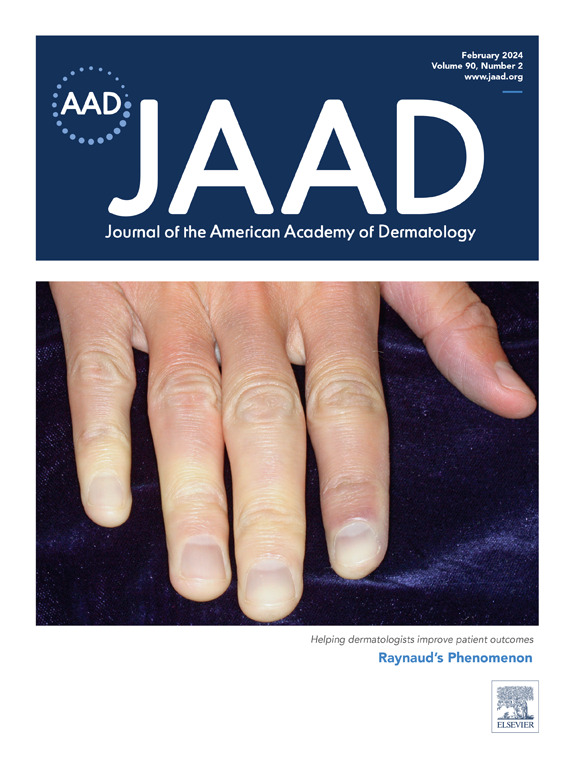分析非热大气等离子体治疗小儿疣的随机对照试验
IF 12.8
1区 医学
Q1 DERMATOLOGY
Journal of the American Academy of Dermatology
Pub Date : 2025-01-01
DOI:10.1016/j.jaad.2024.07.1522
引用次数: 0
摘要
背景:寻常疣(VV)是儿童常见的病毒性疾病。由于疼痛或不良反应风险,儿童往往不能很好地接受治疗方案。非热大气等离子体(NTAP)能产生活性氧/氮物种,耐受性好且无不良反应:确定 NTAP 与标准疗法(SOC)治疗儿童 VV 的疗效:这项前瞻性开放标签研究以 1:1 的比例随机分配病例接受 NTAP 或 SOC(冷冻疗法)治疗。患者每隔 4 周接受一次治疗,最多治疗 3 次。最后一次治疗后四周,对患者的持续反应进行评估。主要结果是病变反应:14名患者的112个VV病灶被纳入研究。患者多为白人(92.9%)、男性(71.4%),平均年龄为 9.5 [±2.5] 岁。SOC和NTAP治疗病灶的反应分别包括:无反应(5.4%,7.1%);部分反应(33.9%,41.1%);完全缓解(60.7%,51.8%;P值=0.679)。患者更有可能在治疗后报告 SOC 病灶疼痛(p-value):限制因素包括治疗部位单一、最多治疗三次以及治疗后随访时间短:结论:NTAP 是治疗儿童 VV 的一种有效、安全的干预方法。本文章由计算机程序翻译,如有差异,请以英文原文为准。
A randomized controlled trial analyzing nonthermal atmospheric plasma for the treatment of verruca vulgaris in pediatric patients
Background
Verruca vulgaris (VV) is a common viral disease in children. Treatment options are often not well tolerated in children due to pain or adverse effect risk. Nonthermal atmospheric plasma (NTAP), which generates reactive oxygen/nitrogen species, is well tolerated and without adverse effects.
Objective
Determine efficacy of NTAP as compared to standard of care (SOC) therapy for VV in children.
Methods
This prospective open-label study randomized lesions 1:1 to receive NTAP or SOC (cryotherapy). Patients were treated at 4-week intervals for a maximum of 3 treatments. They were evaluated 4 weeks postfinal treatment for sustained response. Primary outcome was lesion response.
Results
One hundred twelve VV lesions in 14 patients were enrolled. Patients were mostly White (92.9%) males (71.4%) with mean age of 9.5 [±2.5] years. Responses of SOC- and NTAP-treated lesions, respectively, included no response (5.4%, 7.1%); partial response (33.9%, 41.1%); and complete resolution (60.7%, 51.8%; P value = .679). Patients were more likely to report pain in SOC lesions post-treatment (P value <.001). No significant adverse events (AEs) occurred.
Limitations
Limitations include single-site, maximum of 3 treatments, and short post-treatment follow-up.
Conclusion
NTAP is an efficacious, safe intervention for treatment of VV in children.
求助全文
通过发布文献求助,成功后即可免费获取论文全文。
去求助
来源期刊
CiteScore
8.60
自引率
5.80%
发文量
2023
审稿时长
49 days
期刊介绍:
The Journal of the American Academy of Dermatology (JAAD) is the official scientific publication of the American Academy of Dermatology (AAD). Its primary goal is to cater to the educational requirements of the dermatology community. Being the top journal in the field, JAAD publishes original articles that have undergone peer review. These articles primarily focus on clinical, investigative, and population-based studies related to dermatology. Another key area of emphasis is research on healthcare delivery and quality of care. JAAD also highlights high-quality, cost-effective, and innovative treatments within the field. In addition to this, the journal covers new diagnostic techniques and various other topics relevant to the prevention, diagnosis, and treatment of skin, hair, and nail disorders.

 求助内容:
求助内容: 应助结果提醒方式:
应助结果提醒方式:


